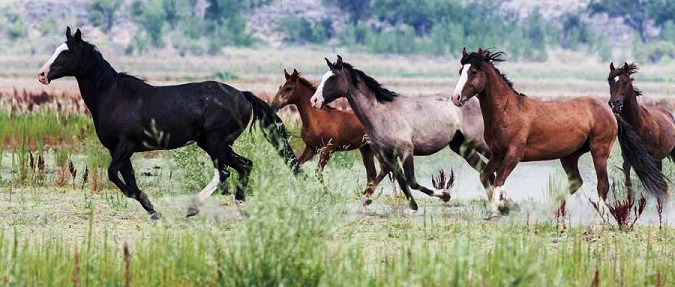I was catching up on some news at my local coffee shop the other day. When it was time for a refill of my coffee, the server asked me to say “when” my cup was full enough. At the time, I was reading about how the Bureau of Land Management (BLM) Advisory Council was recommending new strategies for the reduction in the number of feral horses and burros on federal public land. The same thought occurred to me. It was time to say “when.” It’s time for the BLM to take action and get this problem under control.

As a member of the Boone and Crockett Club, the oldest wildlife conservation organization in North America, I was quite familiar with the feral horse and burro issue. This has been growing and contentious environmental issue for quite some time. In 2011, the Club published a position statement encouraging a new strategy so that the law we already have in place is followed, which is exactly what the BLM Advisory Council is now proposing. This issue has been growing because feral horse numbers on public land and held in special holding facilities have exploded from 25,000 in 1971 to 118,000 this year. The feral horse problem is contentious because some want to see these animals left alone without any management. Others agree their numbers must be controlled but disagree on how-nonlethal (meaning capture, sterilization and adoption) versus lethal (euthanasia) when all else fails.
Feral horse and burro populations have the ability to double in size in four to five years. Unchecked, they have been wreaking havoc on sensitive, arid rangeland ecosystems and limited water resources. The population levels thought by the BLM to achieve ecological balance is currently being exceeded by about 47,000 free-roaming animals, making it impossible for the BLM to satisfy its conflicting dual mandate to both protect feral horses and protect wildlife habitat from deterioration.
One of the Advisory Council’s recommendations is removing all excess animals within the next three years. The BLM already has a statutory obligation under the Wild Free-Roaming Horses and Burros Act of 1971 (Act) to determine the appropriate populations levels and to remove excess animals through lethal means if necessary.
Since the Act was passed, the killing of excess animals has been off the table and management has been limited to capture, sterilizations and holding these animals in government-run, taxpayer-funded holding facilities awaiting adoption. Despite aggressively marketing an adoption program, the BLM reports that demand for these animals is way down from where it once was and a mere fraction of what is needed to keep up with surging population growth. As a result, over $52 million of the BLM’s feral horse and burro program’s approximately $80 million budget is spent on feeding and vaccinating horses already removed from the range and held in these holding facilities.
No one, including sportsmen like myself or the ranchers and ecologists I know, are happy about the prospect of killing horses. Many of these folks own horses themselves, but are realistic about what the carrying capacity of the land means to all wildlife and people. I’ve been in areas where there were feral horses. They are very destructive to the landscape, especially around precious water holes. But, I must admit seeing a stallion leading his herd, galloping across a sage flat is something to behold. Still no species-wild or domestic-should be allowed to destroy our natural places.
Unfortunately, this whole situation is just another example where wildlife and habitat management is being influenced by something other than science, efforts to preserve ecological integrity, and common sense. I dislike using the term “emotional arguments,” but it applies in this case to the rationalizations behind not following the law Congress passed. I’m also struggling with why people who claim to care about animal welfare, and oppose the control of wild horses, are not concerned with the wild species that share these rangelands. Many of these species are on the U.S. Geological Survey’s recent list of Species of Greatest Conservation Need. It’s irresponsible to think we can continue to allow feral horse populations to continue growing unchecked, and forsake all other wildlife and land uses simply because the solution is emotionally difficult to accept.
Congress has determined feral horses and burros represent a part of American history and belong on the range, but healthy ecosystems and proper wildlife conservation of native wildlife is also an important part of our history Americans expect to continue. The BLM has an active adoption program and I encourage more people to step up and use it if they can. I also wish there was an effective method for widespread, long-lasting fertility control. But, until there is, let’s urge the BLM to follow the laws we already have on the books to start solving this problem now and work towards population levels that preserve feral horses, native wildlife, and our ability to enjoy our wide-open spaces. The history of conservation is punctuated with tough decisions that had to be made-including when to say “when.”
